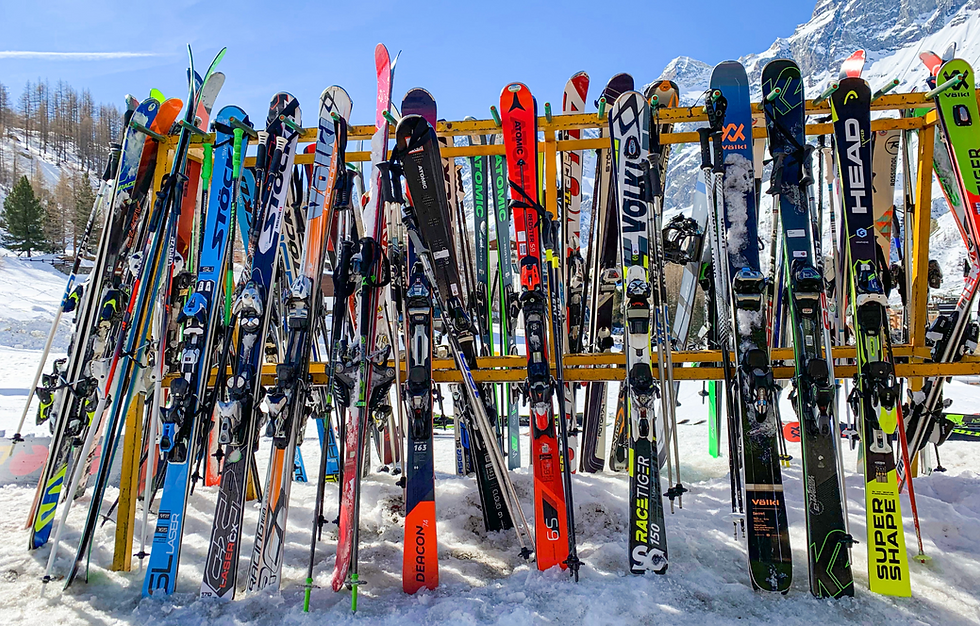The Evolution and Innovation of Ski Boots Part 2a: An Impossible Design Challenge?
- Colton Barry
- Jan 13, 2024
- 4 min read
Updated: Mar 19


All ski boots are designed with two main ideas in mind: Performance and Comfort. Each of these ideas poses significant design challenges individually, but creating a high-performing ski boot that's also very comfortable seems nearly impossible, at least with the current overlap and 3-piece ski boot designs (the two most common designs). What improves performance often reduces comfort and vice versa. As an avid skier and a mechanical engineer by training, this incredibly complex design challenge both frustrates and excites me. There should be a comfortable and high-performing ski boot. Snowboarders figured it out a long time ago. Because this topic interests me and I wanted to learn more about it, I did some digging and want to share my initial insights with you, starting with Performance.
Ski Boot and Overal Skiing Performance
Designing a ski boot for performance comes with significant challenges. I believe the two most significant challenges are the immense variability of skiers in age, size, type, and experience level, and the lack of standardization in the industry.
Let's first look at these two major challenges while considering just one design aspect of a ski boot: Flex. The Flex of a ski boot is essentially the amount of resistance a skier encounters when they lean forward in their boot to make a turn. The higher the flex, the greater the resistance and the greater the force a skier must exert with their leg and ankle to turn effectively. Flex directly contributes to the speed a skier can achieve as well as the amount of control and precision they have at that speed. Flexing forward in a ski boot stores potential energy, and flexing backward releases it, increasing speed. The higher the flex, the more energy can be stored, resulting in a greater increase in speed. Alpine ski racers need a very high flex compared to the general skiing population so they can store more potential energy and release it with every turn, gaining more speed while maintaining high precision and control. Now take a beginner skier. If they were put into a high-flex ski racing boot, they probably wouldn't have the strength nor the technique to make any turns at all. So, a beginner skier requires a much different boot design with much less flex. Now imagine another scenario. Let's say you are buying new ski boots and really like the 95 Flex of your K2 ski boots. So, you purchase Tecnica with 95 flex. Odds are, the flex of the Tecnica's will feel different than your old K2's when you're skiing because each company has its own Flex scale. While there are somewhat standard ranges for Flex for different experience levels of skiers, there is not a common unit for Flex in the ski boot industry.
Breaking down the Flex example, first, there are different Flexes for different skiers, and there's immense variability in who skis. It's a family sport and an activity that you can do your entire life. On any given day, you can see parents teaching their 2-year-old how to ski and a 90-year-old on the same run. You can also see skiers of all downhill skiing types and experience levels, from novice to Olympian. On an average day at Steamboat, I usually see alpine racers, mogul skiers, telemarkers, big-mountain skiers, and many people just out having fun. The immense variability of skier age, size, type, and experience level makes designing a high-performing ski boot or a boot with optimal flex really challenging, if not impossible. This is because each person has their own definition of skiing performance and different requirements from a boot that enable them to ski at a high level. Currently, many companies either specialize in making a boot to fit a particular niche of skier, such as the former company Full-Tilt (now owned and operated by K2) that made comfortable 3-piece boots tailored toward park skiers, or have different departments for the different groups of skiers, such as the Lange Racing division. As such, people can usually find a boot that fits their general category of skier (e.g., beginner female skier aged 40...) through a simple Google search or by going into a ski shop and asking experts. However, this also introduces the second major problem, lack of standardization.
Going back to the flex example, it seems to me like the lack of standardization with something as crucial as flex makes the R&D process for ski boots way more challenging and inefficient than it needs to be. How can you test the performance of boots from two different companies if an 80 flex of one is an 82.5 of another? There shouldn't be resources spent trying to develop a flex conversion between boots. But if it's not done, then companies are stuck comparing two of their own designs, which can be helpful, but not favorable. The lack of standardization with ski boots astonishes me, and it definitely goes beyond flex. With that said, it makes me think of the opportunities and innovation that would be gained from someone creating a standardized scale for everything ski boot related...







Comments